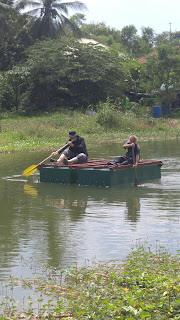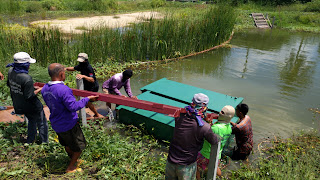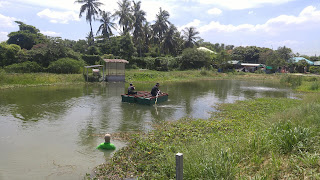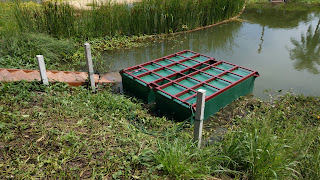I’ve been writing a lot about the experimental pontoons we’ve been building recently. Well, yesterday we got a chance to assemble them into a kind of rough boat (raft?) and take it out onto the pond.
First the welding team along with the help of some of the construction workers carried both of the pontoons over to the stairway down into the pond and tried floating it in water for the first time.
Then we carried the steel frame over and laid it down on the pontoons in the water and bolted it together.
At this point we were able to climb on board and see what kind of buoyancy it really has. The number I observed is that when one or two people were already standing on the platform, the pontoon was about 5-10cm submerged. When I climbed on board and stood exactly at one corner, it seemed to drop by a little less than 10cm more (just in that corner). This makes a rough sense since one pontoon has a surface area of about 2.4m² so two pontoons have a surface area of 4.8m². If we assume that by standing in one corner of the boat about ¼ of the surface area of the bottom of the boat is supporting me, then how much deeper would 1.2m² be pushed down by my weight? With shoes and equipment in my pockets, I weigh almost 100kg. 100kg of water is 0.1m³.
0.1m³ / 1.2m² = 0.083m or 8.3cm
This is pretty close to the amount I observed.
So finally, I took two old oars from our long tailed canal boat and K’Tanawat and I climbed aboard and rowed out into the pond.
We rowed one lap of the pond together. It was quite fun really! Since the pontoon raft at this point has no rudder or any real concept of “front”, “back”, or “sides” (it is basically a flat square on the bottom), it required some care to synchronize our rowing on side to keep from turning when we didn’t want to. But I was pretty surprised that it moved easily and manoeuvred well. I expected that such a boxy design would provide more resistance than it did. This bodes well for adding electric motors and possibly electric rudders front and back to make it fully autonomous control.
The next step will be to add the floor panels and rails. Additionally, I plan to order about 400kg of steel rebar for ballast, and some used motorcycle tires to place around the sides to reduce the impact of collisions.
At this point the pontoon raft is docked on some cement poles we drove into the ground next to the stairway leading down into the pond making getting on and off quite easy and convenient.










